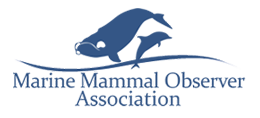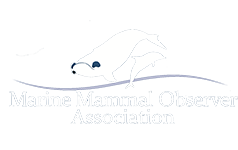The Marine Mammal Observer Association (MMOA) considers that mitigation training courses are a crucial component of implementing effective mitigation measures at sea and allows both MMOs and PAM Operators to work safely and to collect data in a consistent way. The MMOA has the following advice regarding the content and provision of training courses for MMOs and PAM Operators.
MMO and PAM Mitigation training courses
A MMO or PAM mitigation training certificate should not be the only requirement to qualify a person as a MMO or PAM Operator. MMO and PAM mitigation training courses should only act as a supplementary qualification for a person who already has the appropriate academic and/or marine mammal field experience to work as a MMO or PAM Operator. The MMOA note that mitigation training course providers should not advertise their courses to be the only qualification needed to become a MMO or PAM Operator, and nor should regulators, clients or MMO and PAM Operator providers consider mitigation training certificates to be such.
MMO and PAM mitigation training courses should serve to provide new MMOs and PAM Operators with the necessary knowledge to enable them to perform appropriately in a mitigation role and to be aware of their duties and responsibilities while implementing mitigation measures.
MMO and PAM Mitigation training course content (generic components)
In some countries regulatory bodies have formalised training requirements and where that is the case those requirements must be strictly adhered to. Additionally, the MMOA recommends that all mitigation training courses worldwide should include the following generic components:
- The importance of sound to marine mammals.
- The potential effects of anthropogenic sound on marine mammals and other SoC (if applicable) including acoustic criteria used to define zones of disturbance and injury.
- Visual monitoring techniques, including methods for range estimation (in MMO courses).
- Field identification (visual or acoustic) of marine mammal and other SoC (if applicable) – noting that course attendees should already have some practical experience with marine mammal identifications or seek to gain this after attending the course and prior to mitigation work.
- The mitigation procedures being used in the geographic region.
- Soft start principles, procedures and monitoring.
- Mitigation Zones.
- An understanding of the industry operations that require MMOs.
- The role of the MMO
- Attending project start-up meetings.
- Monitoring for marine mammals and other SoC (if applicable).
- Monitoring of compliance with mitigation procedures (i.e. compliant source operations).
- Mitigating for SoC inside mitigation zones prior to operations, during soft start (if applicable) and during full power operations (if applicable).
- Scenarios that may arise and how to deal with these.
- Interaction with industry personnel and procedures in place, in particular, QHSE requirements.
- Recording MMO and/or PAM data and compliance reporting.
- Chains of command on-board industrial platforms.
- Conduct of MMOs and PAM Operators
- Life on board and personal safety
Additional MMO and PAM Mitigation training course content (specific to geographic area)
Where regulatory bodies have formalised training requirements, those requirements must be strictly adhered to. Elsewhere, the MMOA recommends that mitigation training courses for specific geographic areas should include the following components:
● Understanding the background and development of the adopted mitigation procedures and their legislative framework.
● Consent and permitting process of the procedures prior to projects.
● Specific explanation of the mitigation procedures for the geographic area.
● Identifying species likely to be in the geographic area and which of these should be regarded as SoC.
● Discussing specific project data collection if applicable.
Specific PAM Operator mitigation training (theory and software training)
● Basic theoretical principles of sound.
● Recognition of different types of SoC vocalisations.
● Discussion of types of unwanted ambient noise and masking problems.
● Components of PAM equipment – cables, hydrophone elements, sound cards, filtering systems, depth sensors, laptops and software – assembly, deployment and calibration.
● Discussion of deployment scenarios and examples.
● Principle components of PAM software – displays and the need for project-specific configuration.
● Specific software training – e.g. PAMGuard – practical instruction in creating configurations and basic settings relating to hardware used and method of deployment.
● Discussion of bearing determination and the problem of ranging acoustic signals.
Specific PAM Operator mitigation training (assembly and deployment)
PAM training is only complete when a person has learnt how to assemble PAM equipment and deploy it in a safe and sufficient way to maximise the detection of vocalising animals. Experience of at-sea deployment is hard to gain as there is a lack of practical training courses worldwide offering this facility. No PAM Operator should take sole responsibility on an offshore mitigation job without having some prior deployment experience. They could gain such experience from joining research groups who carry out acoustic monitoring work, attend a PAM training course offering at sea deployment experience or work on an offshore mitigation project alongside an experienced PAM Operator for a probationary period.
MMO and PAM Mitigation training course instructors
The responsibility for determining who provides MMO and PAM mitigation training courses falls with the regulator for the geographic region in question. However, the MMOA believes that the following criteria should be met by people wishing to act as MMO or PAM mitigation training course providers:
● Must demonstrate that an instructor has good presentation and teaching skills.
● Be able to compile clear, interesting and professional training material such as PowerPoint presentations, training manuals, supporting reading material and practical interactive sessions.
● Have an extensive background in visual and/or acoustic marine mammal survey techniques and species identification.
● Be knowledgeable with respect to the effects of anthropogenic sound on marine mammals.
● Have experience of responsibility as a lead MMO in a wide range of offshore industrial operations. If the course is aimed at mitigation during seismic surveys, then the Instructor should have first-hand experience of working on several survey types such as site surveys, VSP, OBC, 2D/3D and 4D surveys. If the course covers additional operations such as pile driving or explosive work then the instructor should also have had the experience of working as a MMO on such projects.

